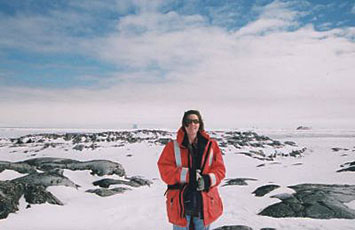Allison McComiskey: An Observer of the Natural World
McComiskey's childhood curiosity in the environment led to a career in atmospheric science research and her current position as chair of Brookhaven Lab's Environmental and Climate Sciences Department
October 21, 2019
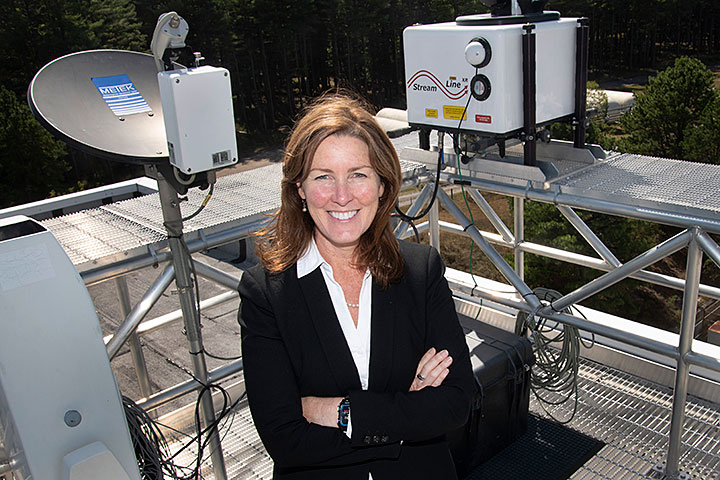 enlarge
enlarge
Allison McComiskey, chair of Brookhaven Lab's Environmental and Climate Sciences Department, on the recently upgraded solar base station. This elevated platform is equipped with instruments for precisely measuring the amount of energy incoming from the sun onto the earth's surface.
“Why are the bottoms of clouds flat?” “Why is that sand dune shaped like that?” Allison McComiskey remembers asking her father these and similar questions during the long road trips her family took in the summers across the country from their hometown of New Orleans, Louisiana.
“I don’t know if I was innately interested but I was always asking questions as we drove down the road,” said McComiskey, who is now the chair of the Environmental and Climate Sciences Department at the U.S. Department of Energy’s (DOE) Brookhaven National Laboratory. “My parents were very science-oriented people—my dad was a physician and my mom was really interested in archaeology.”
A lifelong interest
McComiskey’s childhood curiosity in the environment never left her. As an undergraduate at Southern Methodist University, McComiskey started studying biology in pursuit of the premedical track. But she soon switched her major to anthropology. After graduating, she became a field archaeologist at an environmental consulting firm. Yet something was missing.
“I wanted to contribute, to do something, for the world,” said McComiskey. “I wanted a career that was more forward looking than anthropology.”
That yearning drove her to go back to school. She began a graduate program in geography—what McComiskey describes as the interaction of humans with the environment—at Northern Arizona University. In her first semester, she enrolled in a remote-sensing class.
“I had no idea what it was beyond the course catalog description of looking at imagery of earth from space-based satellite systems,” said McComiskey. “I would say by the second week of that class, I knew that this is what I wanted to do. My thesis project focused on the remote sensing of clouds.”
Despite this conviction, partway through graduate school, McComiskey almost dropped out to become a science writer, even participating in the competitive Santa Fe Science Writing Workshop. But she realized she was better suited for the science part rather than the writing part. After graduating with her master’s degree, McComiskey continued her studies in geography in a PhD program at the University of California, Santa Barbara.
For her PhD research, funded by the National Science Foundation, she collected solar radiation measurements at Antarctica’s coastline.
“At the coastline, you can look in one direction and see a bright glacier, and the other direction and see a dark ocean with no sea ice,” said McComiskey. “I was trying to understand how this surface configuration and clouds impact the amount of ultraviolet radiation reaching the ocean surface, where organisms that make up the base of the food chain in this very productive ecosystem live.”
McComiskey pursued the PhD intending to enter academia, but after accepting a professorship her first year out, she again found herself seeking more. She applied for a short-term appointment at the National Oceanic and Atmospheric Administration (NOAA) Earth System Research Laboratory that was funded by the Atmospheric Radiation Measurement (ARM) facility, a DOE Office of Science User Facility. What she thought would be a year or two appointment turned into a 15-year career, initially as a researcher and later as a manager. Halfway through her NOAA career, she once more tried to deviate from the path of science when she applied and was accepted into an environmental law program at the University of Colorado Boulder. She was reading law books in preparation for the start of classes when she received a DOE Atmospheric System Research (ASR) grant. Needless to say, she never made it to law school.
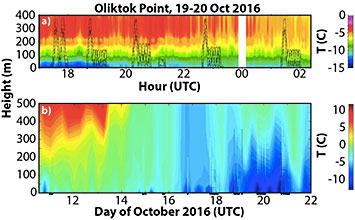 enlarge
enlarge
McComiskey was part of a NOAA–University of Colorado team that went to an extremely isolated part of Alaska known as Oliktok Point to demonstrate the feasibility of using unmanned aerial system (UAS) platforms to collect detailed information about clouds, aerosols, and radiation. In the top-panel plot, temperature measurements collected by a UAS (inside lines) and a ground-based instrument are compared. The bottom panel compares temperature measurements (dots) collected by the UAS with those outputted by a model used for sea ice forecasting (from de Boer et al. 2018).
While at NOAA studying how clouds and aerosols impact earth’s energy budget, she worked very closely with DOE programs. For example, she led the Aerosol Working Group for DOE’s ARM and ASR program and served on various advisory committees and review panels. A few years ago, she went to the North Slope of Alaska, where ARM has deployed a facility to test the use of unmanned aerial systems (UAS) in measuring the vertical profile of atmospheric constituents.
“My background and the kind of science I was really interested in doing was DOE science,” said McComiskey.
From government agency to national lab
Since September 2018, McComiskey has been the chair of Brookhaven Lab’s Environmental and Climate Sciences Department, which conducts research mostly in the areas of atmospheric and terrestrial ecosystem science.
One aspect of her new role that she has really been enjoying is the opportunity to get back into applied science.
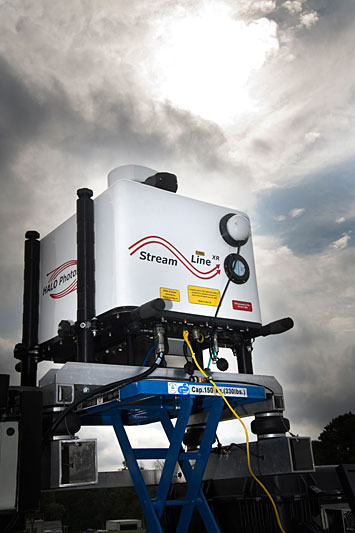
The department recently deployed a sensor-equipped truck that will drive around urban and coastal areas in the Northeastern United States over the next few years to collect atmospheric data about the hard-to-predict microclimates affecting such areas.
“The department mainly focuses on basic climate science research to better understand atmospheric and terrestrial processes and to develop more accurate models for predicting future climate states,” explained McComiskey. “But we use the same expertise to predict the weather on shorter timescales than climate. Such predictions are important when it comes to managing energy resources, especially renewable energy. Our department regularly partners with companies and state and regional organizations to help improve the energy efficiency of renewables.”
Scientists within the department have expertise in measuring clouds, aerosol particles, and plants at the Earth’s land surface; using theory and process science to develop climate and weather models; and developing and deploying new instruments for atmospheric and terrestrial science.
“We measure properties that tell us about the processes we’re interested in representing in the models,” said McComiskey. “You can’t really measure a process.”
For example, aerosols have many different properties, such as size and chemical composition. Members of the department have built a system of instruments that pulls a parcel of air through and measures these properties. The measurements reveal where the aerosols came from—the ocean, tailpipe of a car, a liquid chemical formed after certain gases were emitted from a concrete manufacturer, or some other source. Combined, the physical and chemical properties dictate the aerosols’ optical and radiative properties. Knowing whether the aerosols are scattering or absorbing light can help us understand how they are impacting the atmospheric environment and thus climate. Aerosols that reflect radiation effectively cool the atmosphere, while those that absorb radiation release heat into the atmosphere.
“We collect most of our data with ground-based, as opposed to aircraft- or space-based, sensors,” said McComiskey. “Much of our department’s functions are supported by ARM.”
Allison McComiskey, who co-chairs ARM's Aerosol Measurement Science Group, explains how aerosols are a fundamental part of the climate system in this video released by ARM (June 2020).
On the horizon
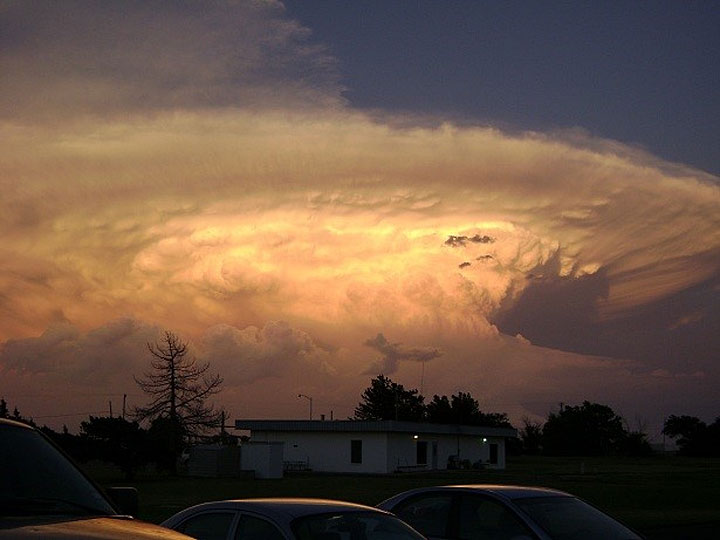
Deep convective clouds will be the focus of an upcoming ARM field campaign in Houston, Texas. Credit: Courtesy of the National Weather Service
McComiskey is looking forward to the department’s upcoming ARM field campaign in Houston, Texas—led by the department’s ASR Science Focus Area Lead Mike Jensen—to begin in 2021. Representing the first large-scale deployment of an ARM facility in an urban environment, this campaign will focus on the impact of pollution and aerosols on convective cloud systems (i.e., those that bring significant storm activity and precipitation). Because Houston often experiences heavy rain and is highly vulnerable to flooding, understanding these dynamics is critical to better prepare the city for extreme weather events.
McComiskey is also interested in seeing how artificial intelligence and machine learning can be used to represent atmospheric and terrestrial processes.
“We’ve built physical models that represent physical systems in a one-on-one way,” said McComiskey. “But physical systems are very complex, and as more computing power becomes available, we’ll be able to develop more accurate models that represent processes at higher and higher resolution. I think we’ll always have physical models, but there are certain applications for which machine learning can be really useful as another avenue to prediction.”
For example, Yangang Liu—lead of the Climate and Process Modeling group in the department—is developing machine learning methods to predict solar and wind energy resources. Another researcher is developing pattern-recognition algorithms to more quickly and uniformly process large atmospheric datasets so that information on data quality can be extracted.
In addition, the department has begun rethinking its measurement paradigm in partnership with Brookhaven’s Instrumentation Division. Traditionally, their approach has been to assemble a very comprehensive suite of complex instruments at a single site, continuously take measurements, and examine these data to understand details of processes. But improving predictive models requires quantifying uncertainties related to spatial variability at relatively small scales—both for extreme cases such as the Antarctic coastline or in more subtle environments like the ARM site in Oklahoma, where changes in topography occur over the complex patchwork of agricultural fields.
One direction the department is beginning to explore is distributed networks made up of low-cost miniaturized instruments, some of which have been developed for UAS use. In one case, they are placing in situ aerosol instruments along with radiometers and other meteorological instrumentation in small suites on the ground to form spatially dense networks. In another case, active remote sensors such as lidars and radars are being placed around urban areas to better understand the complex meteorology of the built environment.
“My hope is that these distributed networks will help us understand the subtleties of the relationships between land surfaces and the atmosphere—in particular how these subtleties come together to create the variability we see over space and time,” said McComiskey.
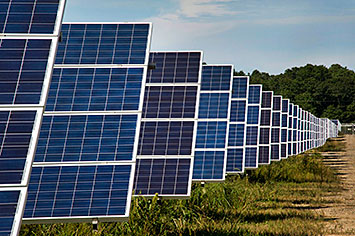 enlarge
enlarge
The Long Island Solar Farm, located at Brookhaven, is the largest solar photovoltaic power plant in the Eastern United States.
For instance, consider the Long Island Solar Farm (LISF) on site at Brookhaven. As clouds roll in over LISF and change in size and move around, they impact the amount of energy that reaches the surface of the solar panels and thus the amount of renewable energy that can be generated at a particular time. The department’s deputy, Paul Kalb, has developed a network of sky imagers and a machine learning algorithm to predict when clouds will shade the panels out up to 30 minutes in advance.
The department is also working with lidar experts to develop ground-based remote-sensing instrumentation that will enable scientists to measure the vertical profiles of aerosols. Otherwise, the only way to obtain this information is to fly a plane around the sky for a given amount of time. A lidar stationed on the ground would not only reduce the cost of data collection but also enable the continuous collection of data to improve understanding of aerosol, cloud, and radiative processes. This work is also contributing to planning exercises for NASA’s next-generation space-based Earth-observing system, which could include a powerful lidar for aerosol and cloud science. McComiskey is serving on the science advisory committee for this mission.
For McComiskey, an observer of the natural world with a curiosity to understand how it works, all of these possibilities are very exciting. The questions she once had as a child have been answered, but many more remain.
“I’m really looking forward to my coming years at Brookhaven,” said McComiskey. “The synergy of support and resources that come from DOE programs and the Lab provides unique opportunities for innovation and operationalizing programs that will help to mitigate the negative societal impacts of energy use. Brookhaven is a great place to be working on the solutions of the future.”
Brookhaven National Laboratory is supported by the Office of Science of the U.S. Department of Energy. The Office of Science is the single largest supporter of basic research in the physical sciences in the United States, and is working to address some of the most pressing challenges of our time. For more information, please visit http://energy.gov/science.
Follow @BrookhavenLab on Twitter or find us on Facebook.
2019-14394 | INT/EXT | Newsroom




